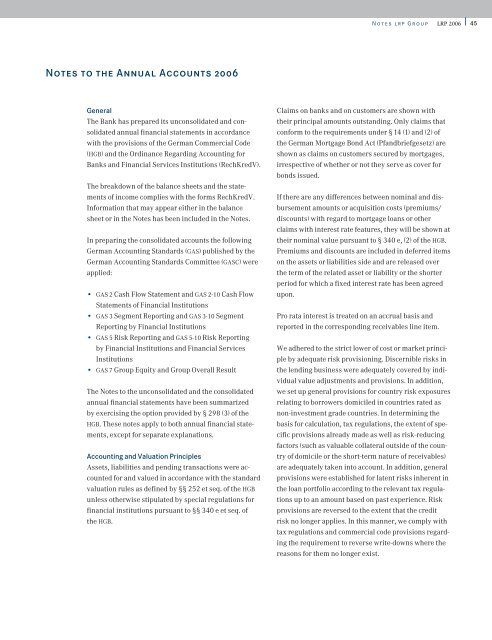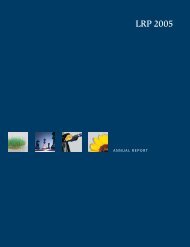Annual Report 2006 - Rheinland Pfalz Bank
Annual Report 2006 - Rheinland Pfalz Bank
Annual Report 2006 - Rheinland Pfalz Bank
Create successful ePaper yourself
Turn your PDF publications into a flip-book with our unique Google optimized e-Paper software.
Notes LRP Group<br />
LRP <strong>2006</strong><br />
45<br />
Notes to the <strong>Annual</strong> Accounts <strong>2006</strong><br />
General<br />
The <strong>Bank</strong> has prepared its unconsolidated and consolidated<br />
annual financial statements in accordance<br />
with the provisions of the German Commercial Code<br />
(HGB) and the Ordinance Regarding Accounting for<br />
<strong>Bank</strong>s and Financial Services Institutions (RechKredV).<br />
The breakdown of the balance sheets and the statements<br />
of income complies with the forms RechKredV.<br />
Information that may appear either in the balance<br />
sheet or in the Notes has been included in the Notes.<br />
In preparing the consolidated accounts the following<br />
German Accounting Standards (GAS) published by the<br />
German Accounting Standards Committee (GASC) were<br />
applied:<br />
• GAS 2 Cash Flow Statement and GAS 2-10 Cash Flow<br />
Statements of Financial Institutions<br />
• GAS 3 Segment <strong>Report</strong>ing and GAS 3-10 Segment<br />
<strong>Report</strong>ing by Financial Institutions<br />
• GAS 5 Risk <strong>Report</strong>ing and GAS 5-10 Risk <strong>Report</strong>ing<br />
by Financial Institutions and Financial Services<br />
Institutions<br />
• GAS 7 Group Equity and Group Overall Result<br />
The Notes to the unconsolidated and the consolidated<br />
annual financial statements have been summarized<br />
by exercising the option provided by § 298 (3) of the<br />
HGB. These notes apply to both annual financial statements,<br />
except for separate explanations.<br />
Accounting and Valuation Principles<br />
Assets, liabilities and pending transactions were accounted<br />
for and valued in accordance with the standard<br />
valuation rules as defined by §§ 252 et seq. of the HGB<br />
unless otherwise stipulated by special regulations for<br />
financial institutions pursuant to §§ 340 e et seq. of<br />
the HGB.<br />
Claims on banks and on customers are shown with<br />
their principal amounts outstanding. Only claims that<br />
conform to the requirements under § 14 (1) and (2) of<br />
the German Mortgage Bond Act (Pfandbriefgesetz) are<br />
shown as claims on customers secured by mortgages,<br />
irrespective of whether or not they serve as cover for<br />
bonds issued.<br />
If there are any differences between nominal and disbursement<br />
amounts or acquisition costs (premiums/<br />
discounts) with regard to mortgage loans or other<br />
claims with interest rate features, they will be shown at<br />
their nominal value pursuant to § 340 e, (2) of the HGB.<br />
Premiums and discounts are included in deferred items<br />
on the assets or liabilities side and are released over<br />
the term of the related asset or liability or the shorter<br />
period for which a fixed interest rate has been agreed<br />
upon.<br />
Pro rata interest is treated on an accrual basis and<br />
reported in the corresponding receivables line item.<br />
We adhered to the strict lower of cost or market principle<br />
by adequate risk provisioning. Discernible risks in<br />
the lending business were adequately covered by individual<br />
value adjustments and provisions. In addition,<br />
we set up general provisions for country risk exposures<br />
relating to borrowers domiciled in countries rated as<br />
non-investment grade countries. In determining the<br />
basis for calculation, tax regulations, the extent of specific<br />
provisions already made as well as risk-reducing<br />
factors (such as valuable collateral outside of the country<br />
of domicile or the short-term nature of receivables)<br />
are adequately taken into account. In addition, general<br />
provisions were established for latent risks inherent in<br />
the loan portfolio according to the relevant tax regulations<br />
up to an amount based on past experience. Risk<br />
provisions are reversed to the extent that the credit<br />
risk no longer applies. In this manner, we comply with<br />
tax regulations and commercial code provisions regarding<br />
the requirement to reverse write-downs where the<br />
reasons for them no longer exist.
















